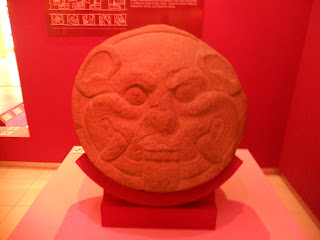On one of these museum trips we made sure to take time to look around again. Within the last year they opened an area that shows the religions of El Salvador and information about Maya and Pipil religions. Those photos came out a bit strange given the red lighting in the room.
Enjoy a look at just some of the artifact and remember that as archaeologists we are much more interested in the information artifacts can tell us about the past than in the objects themselves!
 |
| Statue of Dr. David J. Guzman |
 |
| Called the Virgin of Tazumal (no one seems to know why the stelea is called this) |
 |
| Petroglyphs found in El Salvador |
 |
| Various artifacts including Jade axes (upper left) and various ceramic vessels |
 |
| Ceramic Vessel |
 |
| Jaguar with person in the mouth |
 (Huehueteotl- very old deity in Mesoamerica) (Huehueteotl- very old deity in Mesoamerica) |
| New Deity descriptions from the site |
 |
| Tlaloc- Mesoamerican deity of rain/water |
 |
| Quetzalcoatl- Mesoamerican deity known from many sites throughout Meso. |
 |
| Jaguar Head |
 |
| Large ceramic vessel- the spikes are thought to represent a young ceiba tree (the ceiba tree is very important in Maya cosmology) |
 |
| Toy with wheels- The Maya are not known to have used the wheel for anything other than toys |
 |
| Ceramic Typology (Preclassic Period) |
 |
| Another Preclassic Burial Displayed |
 |
| Ceramic Typology: Classic Period |
 |
| Ceramic Typology: Postclassic Period |
 |
| Ceramic Figurines and Molds |
 |
| Jade Jewlery |
 |
| Ceramic Stamps |
 |
| Jade Beads and Jewelry |
 |
| From the Traveling Peruvian Silver Art Exhibit |







No comments:
Post a Comment